|
|
 |
|
Calanoida ( Order ) |
|
|
|
Diaptomoidea ( Superfamily ) |
|
|
|
Pseudodiaptomidae ( Family ) |
|
|
|
Pseudodiaptomus ( Genus ) |
|
|
| |
Pseudodiaptomus acutus (F.Dahl, 1894) (F,M) | |
| | | | | | | Syn.: | Weismannella acuta Dahl, 1894 c (p.20, figs.F,M);
Schmackeria acutus Poppe & Mrazek, 1895 | | | | Ref.: | | | Marsh, 1933 (p.30, figs.F,M); Wright, 1936 (p.10, figs.F,M); 1937 a (p.162, fig.M); Sewell, 1948 (p.452); Carvalho, 1952 a (p.146, figs.M); Björnberg, 1972 (p.42, figs., Rem.N & juv.); Bowman, 1978 (p.249, fig..F, Rem.); Dussart & Defaye, 1983 (p.29); Grindley, 1984 (p.226); Sazhina, 1985 (p.63, figs. Nauplius); Walter, 1986 (p.131); 1986 a (p.502, fig.1: zoogeogr.); 1987 (p.366); 1989 (p.615, Rem., figs.F,M; Rem.); Bradford-Grieve & al., 1999 (p.884, 951, figs.F,M, p.876: carte); Ferrari & Dahms, 2007 (p.22, 31, 33, Rem. N) |  issued from : T.C. Walter in Bull. Mar. Sc., 1989, 45 (3). [p.617, Fig.14]. Female: A, habitus (dorsal); B, idem (lateral right side); C, last thoracic segments and urosome (lateral left side); D, P5 (anterior view). Male: E, habitus (dorsal); F, idem (lateral right side); G, P5 (posterior view); H, idem (anterior view).
|
 issued from : T.C. Walter in Bull. Mar. Sc., 1989, 45 (3). [p.618, Fig.15]. With doubt. Male variant (from Sao Paulo): A, P5 (posterior view); B, idem (anterior view); C, left exopod 2 of P5 (lateral view). Nota: The variants appeared identical to the normal male except that they were larger (1.10-1.18 mm) and the P5 more than twice as large with differences.
|
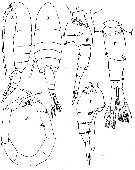 issued from : T.E. Bowman in Crustaceana, 1978, 35 (3). [p.250, Fig.1]. Female (from Kingston Harbor, Jamaica): A, habitus (lateral left side); B, idem (dorsal); C, last thoracic segment and urosome (lateralleft side); D, urosome (lateral right side); E, last thoracic segment and urosome (dorsal); F, P5 (posterior). Nota: Suture between the head and 1st pediger segment is complete laterally, although rather indistinct.5th pediger segment is armed with 2 spines on the left side and 1 spine on the right side (the copepodite V has 1 spine on each side). The genital segment has patches of fine hairs proximally and a group of longer hairs distally on the left side.
|
 issued from : S. Wright in Ann. Acad. Brasileira Sci., 1937, 9 (2). [Pl.1, Fig.4]. Male: 4, right P5.
|
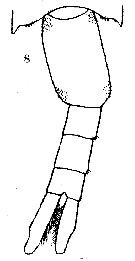 issued from : S. Wright in Annaes. Acad. bras. Cienc., VIII (1), 1936. [Pl.III, Fig.8]. Female : 8, urosome and 5th thoracic segment (the urosome is normally straight).
|
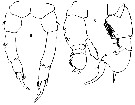 issued from : S. Wright in Annaes. Acad. bras. Cienc., VIII (1), 1936. [Pl.II, Figs.5-6]. Female: 5, P5. Male: 6, P5.
|
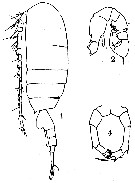 Issued from : C.D. Marsh in Proc. U.S. natn. Mus., 1933, 82 (18) (2959). [Pl. 15, figs.1, 2, 4]. After Dahl, 1894. Female: (from mouth of Amazon): 1, habitus (lateral); 4, P5. Male: 2, P5.
| | | | | Compl. Ref.: | | | Carvalho, 1952 (p.146); Björnberg, 1963 (p.45, Rem.); Jacoby & Youngbluth, 1983 (p.77, fig.1, Table 2, 3, Rem: mating behavior); Lopes, 1994 (tab.1); Mauchline, 1998 (p.508, tab.47, 56); Lopes & al., 1998 (p.195); Suarez-Morales & Gasca, 1998 a (p.111); Ara, 2001 b (p.121); 2004 (p.179, figs.3,4,5); Medeiros & al., 2006 (p.243), Table 1); Sterza & Fernades, 2006 (p.95, Table 1, occurrence); Morales-Ramirez & Suarez-Morales, 2008 (p.514); Magalhaes & al., 2009 (p.187, Table 1, %); Medellin-Mora & Navas S., 2010 (p.265, Tab. 2); Magris & al., 2011 (p.260, abundance, interannual variability); Costa R.G. da & al., 2011 (p.364, Table 1, seasonal occurrence); Almeida LR. & al., 2012 (p.13, Table 1, abundance); Miyashita & al., 2012 (p.1557, Table 2: occurrence); Araujo & al., 2016 (p.1, Table 3, abundance, %); Atique & al., 2017 (p.1, Table 1); Dias & al., 2018 a (p.189, Rem.: p.196). | | | | NZ: | 2 | | |
|
Distribution map of Pseudodiaptomus acutus by geographical zones
|
| | | 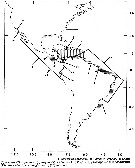 issued from : T.C. Walter in Bull. Mar. Sc., 1989, 45 (3). [p.625, Fig.18]. issued from : T.C. Walter in Bull. Mar. Sc., 1989, 45 (3). [p.625, Fig.18].
Map of American continents showing the zoogeography of Pseudodiaptomus species. |
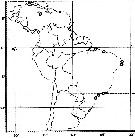 issued from : T.E. Bowman in Crustaceana, 1978, 35 (3). [p.251, Fig.2]. issued from : T.E. Bowman in Crustaceana, 1978, 35 (3). [p.251, Fig.2].
Known distribution if P. acutus.
Nota: Because the coastal and estuarine plankton of northern South America and the Caribbean Islands is inadequately known, it cannot be concluded that the Jamaican population is disjunct. Its presence could be explained by the prevailing current pattern; the northwestern flow of surface water along the northeastern coast of South America is joined near Trinidad by a branch of the North Equatorial Current and continues its northwesterly movement as the Caribbean Current towards the Yucatan Channel. The species could be carried to Jamaica by the clockwise eddy south of Cuba. But there are difficulties with the current-transport hypothesis; whereas the naupliar and copepodite 1 are truly planktonic, the adults are not, but settle on or near the bottom during the day where they are able to attach firmly to substrata. This formis adapted for life in rather shallow water. Another difficulty is the time involved; at 30 miles/day, about 80 days would be required for direct transport from Para (Brazil) to Jamaica; this is a long time for a copepod with a generation of about 25 days and a life span of about 50 days (Jacobs, 1961). A second possible explanation is by the transport of founder specimens in ship's ballast water or in the fouling growth of ship's hullls |
 Issued from : C.A. Jacoby & M.J.Y. Youngbluth in Mar. Biol., 1983, 76. [p.79, Fig.1 A] Issued from : C.A. Jacoby & M.J.Y. Youngbluth in Mar. Biol., 1983, 76. [p.79, Fig.1 A]
Mating sequence of Pseudodiaptomus acutus.
Pair is shown: M male (RA: right A1 grasps the caudal rami of a female F). |
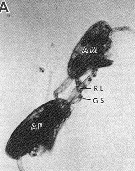 Issued from : C.A. Jacoby & M.J.Y. Youngbluth in Mar. Biol., 1983, 76. [p.83, Fig.2 A] Issued from : C.A. Jacoby & M.J.Y. Youngbluth in Mar. Biol., 1983, 76. [p.83, Fig.2 A]
Mating sequence of Pseudodiaptomus acutus.
Correctly positioned male (AM) on a conspecific female (AF) from the Indian River lagoon near Fort Pierce, Florida, USA.
RL: position of the male"s right P5 relative to the female"s genital somite (GS). |
 Issued from : C.A. Jacoby & M.J.Y. Youngbluth in Mar. Biol., 1983, 76. [p.83, Fig.2 B] Issued from : C.A. Jacoby & M.J.Y. Youngbluth in Mar. Biol., 1983, 76. [p.83, Fig.2 B]
Improper copulatory position in Pseudodiaptomus heterospecific pairs: P. acutus male (AM) posteriad on a female P. cokeri (CF). |
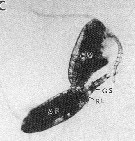 Issued from : C.A. Jacoby & M.J.Y. Youngbluth in Mar. Biol., 1983, 76. [p.83, Fig.2 C] Issued from : C.A. Jacoby & M.J.Y. Youngbluth in Mar. Biol., 1983, 76. [p.83, Fig.2 C]
Improper copulatory position in Pseudodiaptomus heterospecific pairs: P. cokeri male (AM) anteriad on a female P. acutus (CF). |
 Issued from : C.A. Jacoby & M.J.Y. Youngbluth in Mar. Biol., 1983, 76. [p.83, Fig.2 D] Issued from : C.A. Jacoby & M.J.Y. Youngbluth in Mar. Biol., 1983, 76. [p.83, Fig.2 D]
Improper copulatory position in Pseudodiaptomus heterospecific pairs: misplaced spermatophore (S) of P. coronatus attached to a female P. acutus (AF); spermatophore should be attached to the female"s genital somite (GS).. |
 Issued from : C.A. Jacoby & M.J.Y. Youngbluth in Mar. Biol., 1983, 76. [p.81, Table 2]. Issued from : C.A. Jacoby & M.J.Y. Youngbluth in Mar. Biol., 1983, 76. [p.81, Table 2].
Pseudodiaptomus acutus life history from the Indian River lagoon near Fort Pierce, Florida, USA.
In monocultures of seawater: salinity 34-36 per 1000, 24-26*C.
Nota: After the authors, the three species P. acutus, P. cokeri and P. pelagicus, have similar life histories. These species are demersal, they move near or onto the substratum during the day and migrate into the water column at night.Two of these species P. acutus and P. cokeri are sympatric in the Caribbean (Bowman, 1978) and should exhibit at least one reproductive isolating mechanism. The third species P. pelagicus, is the only member of the genus found along the eastern and Gulf coasts of North America. |
 Issued from : C.A. Jacoby & M.J.Y. Youngbluth in Mar. Biol., 1983, 76. [p.82, Table 3]. Issued from : C.A. Jacoby & M.J.Y. Youngbluth in Mar. Biol., 1983, 76. [p.82, Table 3].
Pseudodiaptomus sp. Characteristics of mating behavior for heterospecific and conspecific pairs between P. acutus, P. pelagicus and P. cokeri from the Indian River lagoon near Fort Pierce, Florida, USA.
In monocultures of seawater: salinity 34-36 per 1000, 24-26*C. |
| | | | Loc: | | | Brazil (Paranagua Bay, Guanabara Bay, Vitoria Bay, Macaé, Bracui, Cananeia Lagoon, Santos Bay, Guarairas Lagoon, Mucuri estuary, Guarau estuary, Tocantins River, Curuça estuary, Ajuruteuq Bay, Caeté Estuary, Amazon estuary, Surinam, Venezuela, Caribbean Colombia (San Andrés y Providencia, Tayrona), Jamaica, Puerto Rico, E Costa Rica | | | | N: | 28 | | | | Lg.: | | | (237) F: 1,1-1,3; M: 0,85; (950) F: 1,14-1,36; M: 0,92-1,05; (1003) F: 1,17; (1012) F: 1,17; M: 0,90; {F: 1,10-1,36; M: 0,85-1,05} | | | | Rem.: | Brackish, estuary.
Incomplete data.
In Americanus species group (acutus subgroup) after Walter & al. 2006, p.203.
Registered by Dahl (1894) at the mouth of the Tocantins River (11.8-12.8 p.1000 salinity and 28°C temperature at the surface). | | | Last update : 12/02/2021 | |
|
|
 Any use of this site for a publication will be mentioned with the following reference : Any use of this site for a publication will be mentioned with the following reference :
Razouls C., Desreumaux N., Kouwenberg J. and de Bovée F., 2005-2025. - Biodiversity of Marine Planktonic Copepods (morphology, geographical distribution and biological data). Sorbonne University, CNRS. Available at http://copepodes.obs-banyuls.fr/en [Accessed December 29, 2025] © copyright 2005-2025 Sorbonne University, CNRS
|
|
 |
 |



















